A Bug's Life and The Blob: True Stories of the Groundwater Ecosystems
Lights, Camera, Action ...
Groundwater ecology research is a developing field within the cave and karst sciences in Australia, and many exciting new discoveries are coming to light. Within the South East of South Australia, limited ecological research has been undertaken in comparison to other areas, but already a significant groundwater flora and fauna have been found. Stygobionts (aquatic troglobites) including syncarids and amphipods, and also dense concentrations of actively-developing stromatolites are amongst the star performers. The stories emerging from the study of these organisms rivals the stuff of Hollywood films. The environments of these organisms include cenotes, crater lakes, springs and cave waters: backdrops as stunning as any film set. Highly diverse aquatic ecosystems are also present and include endemic, rare and threatened species and communities.
This paper will present a summary of the research conducted in the groundwaters of the South East to date. The conservation significance of these ecosystems will also be outlined. The South East, which is the most populated karst aquifer in Australia, is well placed to provide the stage for applied research and the development of bioindicators for monitoring groundwater health. This is particularly important given that a long regional history of groundwater pollution and water extraction has probably impacted on the groundwater ecosystems. Further research is thus needed to fully document the ecosystems and develop groundwater biomonitoring
On Location
The Lower South East of South Australia is a low relief covered karst area dominated by a broad coastal plain on Tertiary marine Gambier Limestone. The coastal plain is overlain by northwest-southeast trending Pleistocene calcareous dune limestones. Several isolated volcanic complexes of recent origin also overlie the limestone (Grimes et al. 1995).
The Gambier Limestone encompasses an extensive unconfined aquifer system. Groundwaters of the unconfined aquifer are readily accessible via lakes associated with enclosed depressions of karst and volcanic origin. Permanent groundwater pools, sumps, fully flooded passages or intermittent subterranean streams that occur in at least 25% of tagged caves, also provide access to groundwater ecosystems.
Three types of enclosed depressions with groundwater lakes are found in the Lower South East (Figure 1). These are:
- Sheer-walled collapse dolines known as cenotes (eg. Black Hole, Gouldens Hole).
- Basin or funnel-shaped dolines intersected by springs (karst spring lakes), which are the main resurgence or outflow points of the unconfined aquifer (eg. Piccaninnie Ponds, Ewens Ponds). Remnants of formerly extensive peat-fen swamps are associated with the spring lakes.
- The Blue Lake, a volcanic maar-cone which is part of the Mount Gambier Volcanic Complex. The Blue Lake is essentially a window to the regional karst water table.
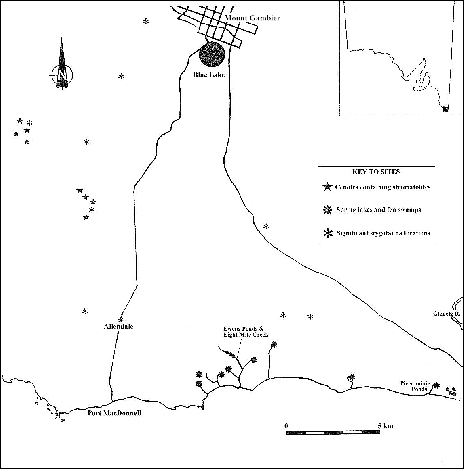
Figure One: Location of Significant Groundwater Ecosystems in the Lower South East of South Australia.
Background Research
A limited number of taxonomic and ecological studies of the groundwater ecosystems have been undertaken. As early as 1943, Constance Eardley recognised the significance of the aquatic plant communities of the spring lake and associated wetlands near Eight Mile Creek. Her study was prompted by impending clearing and drainage of the area for agriculture. Since then, at least five similar studies have been undertaken in the spring lakes, mostly prompted by concern over pollution or perceived recreational impacts.
In the 1980s and 1990s a small dedicated group of cave divers have mapped many of the cenotes, and have collected environmental and ecological information about these environments. Much of this information was produced by the South Australian Underwater Speleological Society (unfortunately now defunct) and is published in the grey literature. With the rise in popularity of SCUBA and cave diving, many popular articles have also been published which provide further information about these ecosystems. There have also been a number of wetland surveys which have included some of the spring locations, as well as general flora and fauna surveys by field naturalist groups and managing authorities. These publications, together with the small number of formal studies, have provided important clues as to the significance of these ecosystems.
The springs and cenotes are in themselves are significant features. The Lower South East of South Australia is the only known location on the continent where these landforms, and their associated ecosystems occur. Grimes et al. (1995) recognise these environments as significant because:
- cenotes are unusual geomorphic features found in only a few regions in the world;
- several cenotes and spring lakes are important geomorphic sites as examples of their genre, and have been listed on the Register of the National Estate, or are Geological Monuments;
- many cenotes and spring lakes are extremely important recreational sites with high aesthetic values;
- the cenotes and spring lakes have high biological values as they support distinct aquatic plant and animal communities, stromatolites and 'cave-adapted' animal species, many of which are endemic, rare and threatened;
- several cenotes are important as palaeontological sites.
The importance of the springs and their associated swamps as wetlands has also been recognised by several authorities (Jones 1978; SEWC 1984; Usback & James 1993).
Stromatolites: Tales of The Blob
One of the most significant features of the groundwater communities of the Lower South East are actively-forming stromatolites. Stromatolites are lithified, laminated, organo-sedimentary deposits which are formed by complex ecological associations of algae, bacteria and other microbes collectively known as benthic microbial communities or BMCs (Burne & Moore 1987).
- Lithification is a geomorphic process which results in the formation of hardened rock from loose sediment
- Lamination is the development of thin, discrete layers of rock, that when viewed in cross-section resemble tree rings.
- Organo-sedimentary deposits are those which form by the interaction of biological organisms with their surrounding environment. In the case of stromatolites, this interaction is due to the BMC trapping suspended sediments in the water surrounding them, and/or biologically inducing precipitation.
Stromatolites have so far been located in eight cenote lakes. The stromatolites develop on the sheer rock walls where they form dense, continuous bands which encircle the entire cenote. Precipitation is thought to be the main mechanism for the development. As the BMCs undergo photosynthesis, the water chemistry in the immediate vicinity is altered by the removal of carbon dioxide, which causes a rise in pH and the precipitation of carbonate minerals (biomineralisation). Precipitation occurs on the outer surface of the stromatolite, where the living BMC is located. The interiors of the stromatolites are solid, finely-laminated, and are composed of fine-grained calcite. Further information is given in Thurgate (1996).
Stromatolite distribution patterns vary with both depth and aspect at any given site. Generally larger structures (>2m) are found at depths of less than 8m in well-lit areas with little overhang. Smaller forms (<1m) are found in alcoves, beneath overhangs and in deeper water where light levels are low. Actively-developing stromatolites extend from the surface of the water table, and persist to depths of up to 25m. In some locations, inactive forms associated with former high water levels can be seen on the cenote walls.
The stromatolites of the cenotes are remarkably diverse. At least 12 distinct forms (morphologies) of stromatolite have been located in Gouldens Hole alone. The more common morphologies include branched and unbranched columns, tabular reefs and plate-shaped domes (Plate 1). Dating of several stromatolite columns from Gouldens and Black Hole indicates ages of between 3 000 and 20 000 years B.P. (Kelly 1998). This relatively long time frame explains in part the large size (> 6m) and diversity of these features.
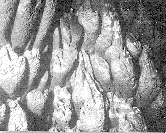 |
 |
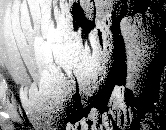
|
| (a) | (b) | (c) |
Plate 1: Examples of stromatolites from Gouldens Hole. (a) simple columnar forms; (b) stromatolite reef, and c) branching columns.
Stromatolites have also been located in the Blue Lake, on both sheer walls and on the sediment-covered lake floor, and they persist to depths of 45 m, but are most common in the upper 25 m. Distribution is patchier than in the cenotes, and the typical morphology is very different. The most common form is the huge tower-like structures of over 10 m length (Plate 2a). At least eight stromatolite morphologies are known from the Blue Lake including various columnar forms and reef-like structures (Plate 2b and 2c). Only one of the columnar forms resembles the stromatolites found in the cenotes (Thurgate 1996; 1998).
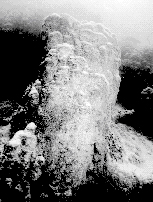 |
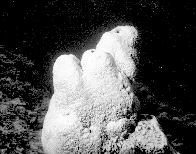 |
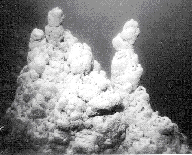 |
| (a) | (b) | (c) |
Plate 2: Examples of stromatolites from the Blue Lake. (a) large tower structure, (b) simple columnar forms, and (c) upper section of stromatolite reef.
The internal structure of the stromatolites of the Blue Lake show crudely developed lamination, they are coarse-grained, and the chemical composition is dominated by low-magnesium calcite. Most of the stromatolite structures are quite soft, poorly lithified particularly near the exterior, and most have a hollow centre. So far, there has been no attempt to date the stromatolites of the Blue Lake.
Best Actor Award: Significance of the Stromatolites
Stromatolites were once one of the most abundant life-forms on the planet, with a fossil history dating back to 3.5 billion years. For reasons that are still not clear, stromatolites declined rapidly in abundance around 570 million years ago, so that in modern times, actively-forming stromatolites are relatively uncommon, if not rare. Scientists are now interested in studying modern stromatolites, because it is believed that they hold the key to understanding the past. For example, the towers, reefs and columns of the Blue Lake display structural variations similar to fossil stromatolite forms recorded elsewhere. By understanding how these modern-day examples are developing, we can gain insight into how ancient stromatolites formed, and the environmental conditions that prevailed in their host environment.
The Lower South East region is of national significance for the conservation of stromatolite biodiversity, as there is greater stromatolite diversity in this region than has been recorded anywhere else in Australia. Grey et al (1990) suggested that an area has a high stromatolite diversity if between four to six morphologies are present. At Shark Bay in Western Australia, up to nine morphological types have been reported, and for some time, this was considered to be the most diverse stromatolite environment on the continent (Hoffman 1976). In contrast, 14 different forms have been identified in the cenotes around Mount Gambier, with an additional seven forms in the Blue Lake. Thus in total, at least 21 distinct stromatolite forms are present within the groundwater ecosystems of the Lower South East.
The Lower South East stromatolites are also significant within Australia because they include:
- the largest individual stromatolite structures (>10m)
- the deepest occurrences of stromatolites (>45 m in the Blue Lake)
- one of the highest densities of stromatolite distribution from a single region
- the only known occurrences of stromatolites in freshwater crater lakes and in cenotes
Globally, stromatolites have been recorded that are larger and which occur at greater depths, and they have also been found in similar environments. However, the diversity of the Lower South East occurrences is unequalled. In addition, it is rare to find branching stromatolites in modern occurrences world-wide, but in the Lower South East, at least seven branching forms are present.
Stygobionts And Other Groundwater Fauna: Tales from A Bug's Life
Fauna associated with groundwater environments both in caves and in cenotes have not been well studied in the Lower South East. However, several stygobionts have been described. The syncarid Koonunga crenarum (Figure 2) has been collected from at least 19 cave and cenote locations in the area (Zeidler 1985). The amphipod Uronyctus longicaudus has been collected from two cenote locations (Stock & Illiffe 1990). Both species are obligate stygobionts which are endemic to the subterranean waters of the Lower South East.
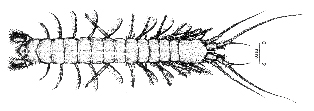
Figure 2: The syncarid Koonunga crenarum (From Zeidler 1983)
Syncarids are relictual fauna that can provide valuable insights into the zoogeographic and evolutionary history of southern continental faunas. Syncarids are regarded as 'living fossils' with an extremely conservative morphology that closely resembles their fossil ancestors. Syncarids are rare on the Australian mainland and occur in highly localised but widely separated locations (Eberhardt & Spate 1995). K. crenarum is the largest mainland syncarid species recorded to date and it is thought to have Gondwanan origins.
U. longicaudus represents a new amphipod genus, which is convergent with genera from Europe and Asia. It also belongs to a family that include Gondwanan ancestors. Further surveys are required to confirm whether this amphipod occurs elsewhere in the Lower South East, but based on current information, this species has a very restricted distribution.
Overall, the crustacean fauna of the cenote and spring lake environments is very diverse. Aside from the stygofauna, these environments also support at least six species of freshwater crayfish including Cherax spp., Engaeus spp and Euastacus bispinosus, at least three additional amphipods, one shrimp, one crab, and numerous planktonic ostracods, copepods and cladocerans (Zeidler 1983).
The molluscan fauna is also very diverse. At least four bivalves (mussels) and nine gastropods (snails) have been recorded so far in Ewens and Piccaninnie Ponds alone. This includes the freshwater mussel, Hydridella (Hydridella) narracanensis, previously only known from central Victoria and Tasmania. This species has been recorded as an isolated population in Eight Mile Creek, which drains from Ewens Ponds (Zeidler 1983).
The Plot Thickens
The groundwater ecosystems of the Lower South East are highly significant, but their long-term survival is seriously threatened. Pollution from a variety of diffuse and point sources, as well as lowering of the water table are considered the major threats (Gillieson & Thurgate In Press). High nutrient levels (especially nitrate) in the groundwater have been reported for some time. This has resulted in part from the dumping of livestock carcasses into karst depressions, the release of dairy industry effluent, and waste-spreading on pasture and pine forest. The use of herbicides, pesticides, other chemicals have also added to the problem.
In the spring lakes, most of the surrounding swamp environments have been drained and cleared, so that there is little buffering the spring lakes from the impacts of the surrounding land uses. At some localities, livestock create havoc at the lake shores by trampling the edges and fouling the water. In the cenotes, blooms of blue-green algae are now common each summer, and threaten not only the animals living in this environment, but also the stromatolites.
In addition to groundwater pollution, the groundwater supplies may be under threat. Over recent years, there has been an increase in the number of extractive industries drawing groundwater for irrigation. Poor rainfall over the last decade has also taken its toll, reducing recharge to the aquifer, and also prompting landholders to increase their dependence on groundwater supplies. The combination of reduced rainfall and increasing demands on the aquifer has lead to a substantial drop in the regional water table. Several of the shallower spring lake systems are on the verge of drying out completely, and in the cenotes, the upper sections of the active stromatolite beds are being left high and dry.
Twists and Turns
Clearly, management to conserve these groundwater ecosystems is required, as are the development of tools for assessing impacts. To some extent, this is being achieved by regional authorities, but the main focus to date has been to maintain water quality and quantity. While these are important goals that relate to maintaining ecosystem health, a focus on documenting and protecting the intrinsic biological values of the groundwater is also needed. This can be achieved by improved research efforts and the development of biomonitoring programs. Specific areas which require further research effort include:
- detailed study of stromatolite morphology, distribution, abundance and diversity;
- detailed study of the BMCs and their influence on stromatolite morphology and 'growth'
- systematic, coordinated invertebrate fauna surveys in cenotes, spring lakes and associated swamps;
- targeted searches to establish if other stygofauna is present in the area;
- collection of long-term environmental and biological data for baseline information and monitoring purposes.
The Final Scene
Across the world, nearly all inland aquatic environments are under threat, and many of these are important as water supplies, conservation or recreation sites. In recent years, schemes to determine the 'health' of these various aquatic environments have been developed. All of these programs have adopted biotic indices of water quality by examining the makeup of fauna assemblages and identifying the proportion of pollution-sensitive vs. pollution-tolerant taxa.
In Australia, there is a national project to develop a picture of riverine health, and to develop rapid techniques for assessment purposes (eg. AusRivAS project). A similar scheme to assess karst groundwaters in the USA as been developed (Poulson 1993), but no such scheme is available in Australia at this time. (rather than indicator species). The Lower South East of South Australia is the perfect location to adapt these types of techniques to Australian karst groundwater environments. The groundwater ecosystems are extensive and accessible, and there is detailed documentation of levels of pollution in different parts of aquifer.
A monitoring program of this nature has the advantage of being cost-effective, and provides much more information than the traditional spot checks on the physiochemistry of the groundwater. In order to be successful; the program would need to be developed with the input of karst specialists. In addition, much of the research suggested above would need to be carried out, so it is important to attract funding and researchers to the area as soon as possible. Given the very real and increasing threats to these groundwater environments, and the importance of their associated ecosystems, a groundwater biomonitoring program should be developed for the South East as a matter of urgency.
Bibliography
Burne, R. V. and L. S. Moore. 1987. Microbialites: organosedimentary deposits of benthic microbial communities. Palaios 2:241-54.
Eardley, C. M. 1943. An ecological study of the vegetation of Eight Mile Creek Swamp, a natural South Australian coastal fen. Trans. R. Soc. S. Aust. 67(2):200-223.
Eberhardt, S. and A. P. Spate. 1995. Cave Invertebrate Survey: Toward an Atlas of NSW Cave Fauna. Report to Dept. of Urban Affairs and Planning and Australian Heritage Commission.
Gillieson, D. G. and M. E. Thurgate. In Press. Karst and agriculture in Australia. Int. J. Speleology.
Grey, K., L. S. Moore, R. V. Burne, B. K. Pierson, and J. Bauld. 1990. Lake Thetis, Western Australia: an example of saline lake sedimentation dominated by benthic microbial processes. Marine and Freshwater Biology 41:275-300.
Grimes, K. G., E. Hamilton-Smith, E. and A. P. Spate. 1995. South East Karst Province of South Australia. Unpublished Report. Australasian Cave and Karst Management Association.
Hoffman, P. 1976. Stromatolite morphogenesis in Shark Bay, Western Australia. In M. R. Walter (Ed) Stromatolites. Elsevier Scientific Publishing Company. Amsterdam. 261-272.
Jones, W. 1978. The Wetlands of the South-East of South Australia Nature Conservation Society of South Australia. Adelaide.
Kelly, M. D. 1998. Freshwater stromatolites as potential palaeoenvironmental indicators: a case study of the Lower South East of South Australia. BSc. (Hons.) thesis. Department of Geography and Environmental Science. University of Newcastle.
Poulson, T. L. 1993. Case studies of groundwater biomonitoring in the Mammoth Cave region. In J. Stanford (Ed) Proceedings of the 1st International Conference on Groundwater Ecology American Water Resources Association. 331-340.
Stock, J. H. and T. M. Illiffe. 1990. A new Australian crangonyctid amphipod with a habit convergent to the Old World genus Niphargus. Stygologia 5 (3): 137-142.
South Eastern Wetlands Committee. 1985. Wetland Resources of the South East of South Australia: Investigation of Wetland Areas in the South East of South Australia for Conservation and Recreation Uses SEWC. Adelaide.
Thurgate, M. E. 1996. Stromatolites of the cenote lakes of the Lower South East of South Australia. Helictite 34(1):17-25.
Thurgate, M. E. 1998. Freshwater stromatolites of a karst groundwater-fed system: A case study of the Blue Lake Crater, Lower South East of South Australia. Unpublished report.
Usback, S. and R. James. 1993. A Directory of Important Wetlands in Australia, ANCA. Canberra.
Zeidler, W. 1983. Terrestrial and freshwater invertebrates, excluding insects and arachnids. In M. J. Tyler, C. R. Twidale, J. K. Ling and J. W. Holmes (Eds). Natural History of the South East, Royal Society of South Australia. Adelaide. 186-204
Zeidler, W. 1985. A new species of crustacean (Syncarida: Anaspidacea: Koonungidae), from sinkholes and caves in the South-East of South Australia. Trans. R. Soc. S. Aust., 109 (3): 63-75.